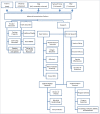Improving rates of maternal immunization: Challenges and opportunities
- PMID: 26552807
- PMCID: PMC4962946
- DOI: 10.1080/21645515.2015.1101524
Improving rates of maternal immunization: Challenges and opportunities
Abstract
Objectives: An increasing number of vaccines are recommended or are being developed for use during pregnancy to protect women, fetuses, and/or newborns. For vaccines that are already recommended, vaccine uptake is variable and well below desired target. We reviewed the literature related to factors that affect a healthcare provider's recommendation and a woman's willingness to be vaccinated during pregnancy.
Design: A scoping review of published literature from 2005 to 2015 was undertaken and all relevant articles were abstracted, summarized, and organized thematically.
Results: Barriers and facilitators were identified that either decreased or increased the likelihood of a healthcare provider offering and a pregnant woman accepting vaccination during pregnancy. Concern about the safety of vaccines given during pregnancy was the most often cited barrier among both the public and healthcare providers. Other barriers included doubt about the effectiveness of the vaccine, lack of knowledge about the burden of disease, and not feeling oneself to be at risk of the infection. Major facilitators for maternal immunization included specific safety information about the vaccine in pregnant women, strong national recommendations, and healthcare providers who both recommended and provided the vaccine to their patients. Systems barriers such as inadequate facilities and staffing, vaccine purchase and storage, and reimbursement for vaccination were also cited. Evidence-based interventions were few, and included text messaging reminders, chart reminders, and standing orders.
Conclusions: In order to have an effective vaccination program, improvements in the uptake of recommended vaccines during pregnancy are needed. A maternal immunization platform is required that normalizes vaccination practice among obstetrical care providers and is supported by basic and continuing education, communication strategy, and a broad range of research.
Keywords: Barriers; maternal immunization; opportunities.
Figures
Similar articles
-
Barriers and facilitators regarding influenza and pertussis maternal vaccination uptake: A multi-center survey of pregnant women in Italy.Eur J Obstet Gynecol Reprod Biol. 2020 Apr;247:10-15. doi: 10.1016/j.ejogrb.2020.02.007. Epub 2020 Feb 5. Eur J Obstet Gynecol Reprod Biol. 2020. PMID: 32044622
-
Knowledge and attitiudes of pregnant women and their providers towards recommendations for immunization during pregnancy.Vaccine. 2015 Oct 5;33(41):5445-5451. doi: 10.1016/j.vaccine.2015.08.028. Epub 2015 Aug 22. Vaccine. 2015. PMID: 26307234
-
Trends in seasonal influenza vaccine uptake during pregnancy in Western Australia: Implications for midwives.Women Birth. 2016 Oct;29(5):423-429. doi: 10.1016/j.wombi.2016.01.009. Epub 2016 Feb 12. Women Birth. 2016. PMID: 26879102
-
Facilitators and barriers to vaccination uptake in pregnancy: A qualitative systematic review.PLoS One. 2024 Apr 19;19(4):e0298407. doi: 10.1371/journal.pone.0298407. eCollection 2024. PLoS One. 2024. PMID: 38640190 Free PMC article.
-
Delivering influenza vaccine to pregnant women.Epidemiol Rev. 2006;28:47-53. doi: 10.1093/epirev/mxj002. Epub 2006 May 26. Epidemiol Rev. 2006. PMID: 16731574 Review.
Cited by
-
Vertically Transferred Immunity in Neonates: Mothers, Mechanisms and Mediators.Front Immunol. 2020 Mar 31;11:555. doi: 10.3389/fimmu.2020.00555. eCollection 2020. Front Immunol. 2020. PMID: 32296443 Free PMC article. Review.
-
Awareness, knowledge, risk perception and uptake of maternal vaccination in rural communities of Ebonyi State, Nigeria.Afr Health Sci. 2022 Dec;22(4):306-317. doi: 10.4314/ahs.v22i4.36. Afr Health Sci. 2022. PMID: 37092060 Free PMC article.
-
Temporal trends and determinants of COVID-19 vaccine series initiation after recent pregnancy.Hum Vaccin Immunother. 2023 Aug 1;19(2):2215150. doi: 10.1080/21645515.2023.2215150. Epub 2023 May 30. Hum Vaccin Immunother. 2023. PMID: 37249316 Free PMC article.
-
Maternal awareness, acceptability and willingness towards respiratory syncytial virus (RSV) vaccination during pregnancy in Ireland.Immun Inflamm Dis. 2024 Apr;12(4):e1257. doi: 10.1002/iid3.1257. Immun Inflamm Dis. 2024. PMID: 38661110 Free PMC article.
-
Why Should We Advocate Maternal Immunization?Pediatr Infect Dis J. 2019 Jun;38(6S Suppl 1):S28-S32. doi: 10.1097/INF.0000000000002312. Pediatr Infect Dis J. 2019. PMID: 31205241 Free PMC article.
References
-
- Lichty JA, Slavin B, Bradford WL. An attempt to increase resistance to pertussis in newborn infants by immunizing their mothers during pregnancy. J Clin Invest 1938; 17(5):613-21; PMID:16694606; http://dx.doi.org/10.1172/JCI100987 - DOI - PMC - PubMed
-
- Adams JM, Kimball AC, Adams FH. Early immunization against pertussis. Am J Dis Child 1947; 74(1):10-8; PMID:20258316; http://dx.doi.org/10.1001/archpedi.1947.02030010017002 - DOI - PubMed
-
- Cohen P, Schneck H, Dubow E. Prenatal multiple immunization. J Pediatr 1951; 38(6):696-704; PMID:14841572; http://dx.doi.org/10.1016/S0022-3476(51)80131-8 - DOI - PubMed
-
- Schofield FD, Tucker VM, Westbrook GR. Neonatal tetanus in New Guinea. Effect of active immunization in pregnancy. Br Med J 1961; 2(5255):785-9; PMID:13748431; http://dx.doi.org/10.1136/bmj.2.5255.785 - DOI - PMC - PubMed
MeSH terms
Substances
LinkOut - more resources
Full Text Sources
Other Literature Sources
Medical

